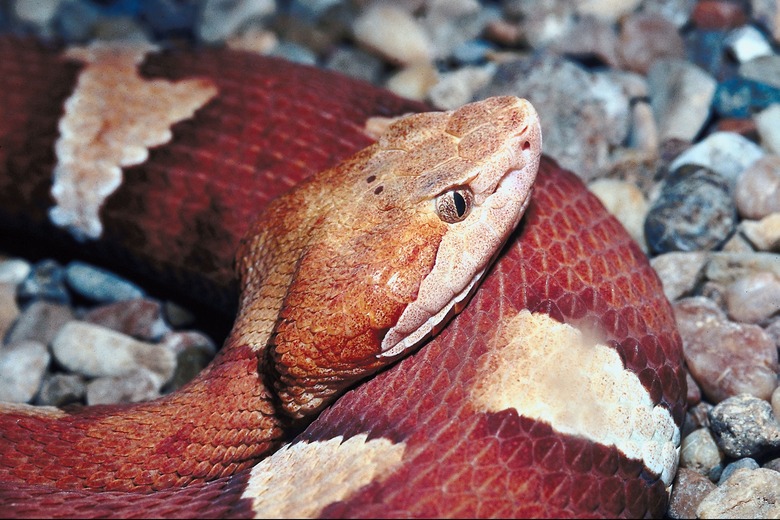Types Of Snakes In Mobile, AL
Mobile, Alabama, features aquatic and terrestrial habitats within the city limits for its snake species. While most of Mobile's snakes live in forested or freshwater environments, one species – the gulf salt marsh snake – is able to live in saltwater habitats. The majority of Mobile's snakes are nonvenomous, but this city is also home to venomous pit vipers and eastern corals. A handful of snakes appear in Mobile's urban settings, such as backyards and city parks.
Eastern Coral Snakes
Eastern Coral Snakes
Belonging to the venomous Elapidae snake family, eastern coral snakes (Micrurus fulvius) live in Mobile's forested areas. These snakes have black-yellow-red ring patterns on their bodies. Eastern coral snakes are fossorial – underground dwellers – and rarely come into the presence of humans. This snake is most active during sunrise and sunset. Contrary to pit vipers, eastern corals have round-shaped pupils and their slender bodies resemble non-venomous Colubrids.
Pine Snakes
Pine Snakes
Pine snakes are nonvenomous species found in pine forest settings within Mobile's city limits. Two subspecies are native to Mobile: black pines and Florida pines. These snakes may be identified by their pointed noses and dark scales. Pine snakes are able to burrow underground if the soil is sandy. This snake preys on underground animals and lays its eggs in burrows. Mobile residents may encounter this snake if they walk in parks with dense forests, such as Langan Park.
Water Snakes
Water Snakes
Mobile's freshwater ponds and lakes are home to five species of nonvenomous Nerodia snakes: midland, Florida green, southern, plain-bellied and brown water snakes. These snakes are able to dive underwater for prey, as opposed to venomous cottonmouths, which are only able to swim on the water's surface. The gulf saltmarsh snake lives in the saltwater environments of Mobile Bay, located next to Mobile.
Kingsnakes
Kingsnakes
Kingsnakes receive their name from their cannibalistic behavior. This snake species preys on other snakes, including venomous species and other kingsnakes. Kingsnakes belong to the Lampropeltis genus of snakes. Three Lampropeltis species live in Mobile: speckled, eastern and scarlet kingsnakes. Eastern kingsnakes are the largest kingsnakes found in Mobile at 3 to 4 feet. The scarlet strongly resembles eastern corals due to their black-red-yellow ring patterns. In Mobile, these snakes may be seen in backyards and parks.
Pit Vipers
Pit Vipers
Five species of venomous pit vipers live in and around Mobile: pygmy rattlesnake, timber rattlesnake, eastern diamondback rattlesnake, copperhead and cottonmouth. The largest of these is the eastern diamondback, which grows between 8 and 9 feet long. Copperheads and cottonmouths are the most abundant pit viper species in Mobile. City residents who live near water encounter cottonmouths, while copperheads often seek refuge in abandoned buildings.
Garter Snakes
Garter Snakes
Two species of garter snakes live in Mobile: eastern garter and eastern ribbon. Mobile residents frequently see these species since garter snakes are not as bashful around humans as other snake species. Garter snakes appear in urban backyards, gardens and forested areas. These snakes are nonvenomous. Both species have stripes running from head to tail.
Cite This Article
MLA
Davis, Skip. "Types Of Snakes In Mobile, AL" sciencing.com, https://www.sciencing.com/types-snakes-mobile-al-10055569/. 24 April 2017.
APA
Davis, Skip. (2017, April 24). Types Of Snakes In Mobile, AL. sciencing.com. Retrieved from https://www.sciencing.com/types-snakes-mobile-al-10055569/
Chicago
Davis, Skip. Types Of Snakes In Mobile, AL last modified August 30, 2022. https://www.sciencing.com/types-snakes-mobile-al-10055569/
